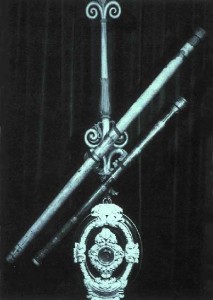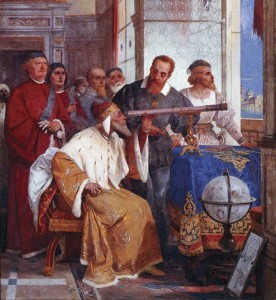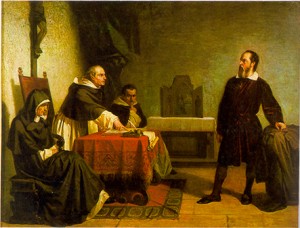Galileo’s Scientific Discoveries:
In 1583, Galileo made his first scientific discovery. He was attending Cathedral of Pisa when he noticed the swinging lamp overhead. He got curious to find out how long it took the lamp to swing back and forth. For this, he used his pulse to time large and small swings. That is when Galileo discovered something that no one else had ever realized: the period of each swing either larger or shorter was exactly the same. We call Galileo’s discovery as the law of isochronism of the pendulum or the law of harmonic motion. He was the one who discovered the motion of uniformly accelerated objects that the objects of different masses fall at the same time.
On August 21, 1609, Galileo introduced his first scientific discovery of the telescope that amazed the whole world. It was sold to the Venetian Senate who were very much impressed and could see the possibility of its usage in military for protecting from sea attacks. Soon after that, Galileo turned his telescope towards sky and explored several discoveries in Cosmology. He discovered that moon was not a smooth sphere, as previously maintained by Aristotelians. It was uneven and rough, like the Earth. He discovered the moons of Jupiter, rings of Saturn, and that the Milky Way is made of many stars. It was when Galileo had directly dared to disprove Aristotelians.
discoveries in Cosmology. He discovered that moon was not a smooth sphere, as previously maintained by Aristotelians. It was uneven and rough, like the Earth. He discovered the moons of Jupiter, rings of Saturn, and that the Milky Way is made of many stars. It was when Galileo had directly dared to disprove Aristotelians.
Galileo discovered one of the greatest discoveries of the world that Earth was not the center of universe. He claimed that Earth is not static but it moves around the sun. He introduced Copernican theory. The concept was unbelievable and against the church Scripture and Aristotalian philosophy. He returned to Florence from Padua ,and with the support of his friend,Pope Urban VIII in Florence, continued his research about the Heliocentric theory. Despite the powerful enemies who could have approach to the greatest force of Europe: the Inquisition, he thought that the Church would accept his discoveries favorably.
research about the Heliocentric theory. Despite the powerful enemies who could have approach to the greatest force of Europe: the Inquisition, he thought that the Church would accept his discoveries favorably.
In 1629, Galileo published his book, Dialogue Concerning the Tow Chief World Systems, about the Heliocentric theory that is considered his masterpiece ever. The book was a dialectical argument set between characters named after his friends Salviati: the authors view about the Sun and Earth, and the Simplicio: the Aristotelian and Church view holder . The enemies then took the advantage of the oppertunity and provoked the pope that Galileo had mocked the pope and the pontiff. In 1632, the publishment of Galileo’s book was banned and he was asked to come to Rome and face the Inquisition within sixty days. On feberuray 13, 1633, Galileo arrived in Rome. He could not defend himself alone against the powerful Inquisition, as result, he was sentenced to house arrest until his death.
. The enemies then took the advantage of the oppertunity and provoked the pope that Galileo had mocked the pope and the pontiff. In 1632, the publishment of Galileo’s book was banned and he was asked to come to Rome and face the Inquisition within sixty days. On feberuray 13, 1633, Galileo arrived in Rome. He could not defend himself alone against the powerful Inquisition, as result, he was sentenced to house arrest until his death.